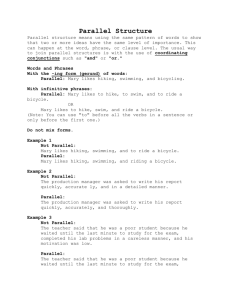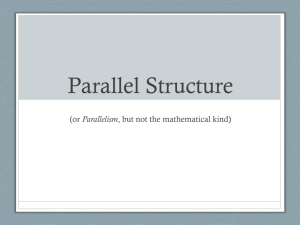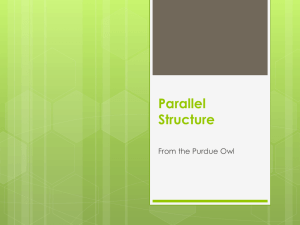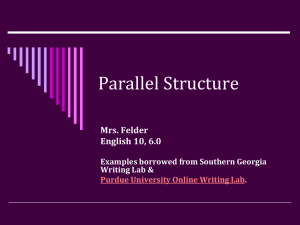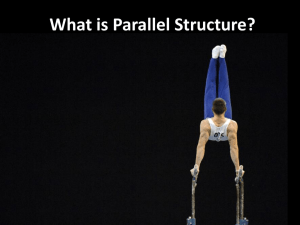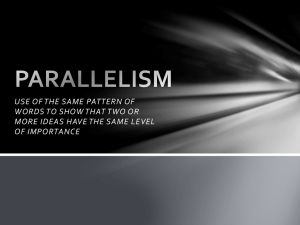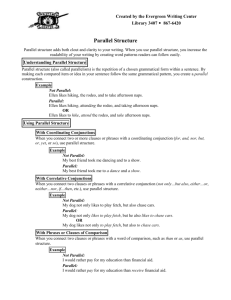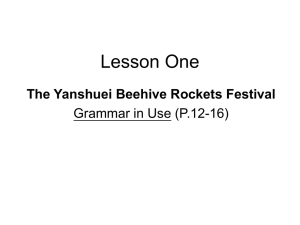Parallel Structure
advertisement
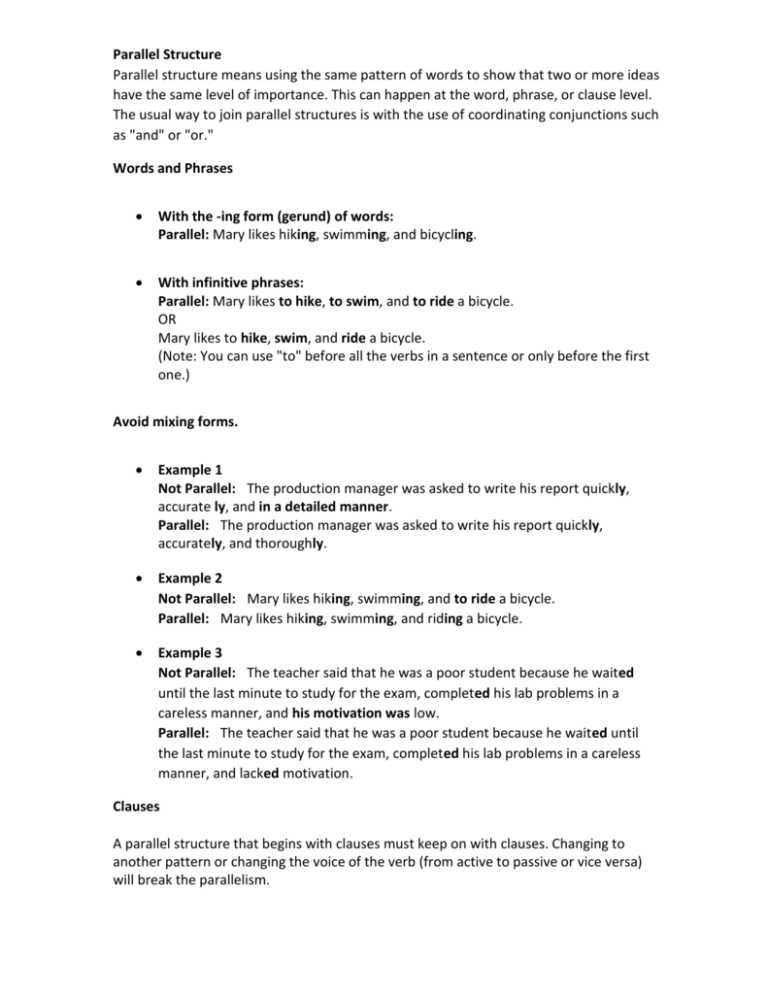
Parallel Structure Parallel structure means using the same pattern of words to show that two or more ideas have the same level of importance. This can happen at the word, phrase, or clause level. The usual way to join parallel structures is with the use of coordinating conjunctions such as "and" or "or." Words and Phrases With the -ing form (gerund) of words: Parallel: Mary likes hiking, swimming, and bicycling. With infinitive phrases: Parallel: Mary likes to hike, to swim, and to ride a bicycle. OR Mary likes to hike, swim, and ride a bicycle. (Note: You can use "to" before all the verbs in a sentence or only before the first one.) Avoid mixing forms. Example 1 Not Parallel: The production manager was asked to write his report quickly, accurate ly, and in a detailed manner. Parallel: The production manager was asked to write his report quickly, accurately, and thoroughly. Example 2 Not Parallel: Mary likes hiking, swimming, and to ride a bicycle. Parallel: Mary likes hiking, swimming, and riding a bicycle. Example 3 Not Parallel: The teacher said that he was a poor student because he waited until the last minute to study for the exam, completed his lab problems in a careless manner, and his motivation was low. Parallel: The teacher said that he was a poor student because he waited until the last minute to study for the exam, completed his lab problems in a careless manner, and lacked motivation. Clauses A parallel structure that begins with clauses must keep on with clauses. Changing to another pattern or changing the voice of the verb (from active to passive or vice versa) will break the parallelism. Example 1 Not Parallel: The coach told the players that they should get a lot of sleep, that they should not eat too much, and to do some warm-up exercises before the game. Parallel: The coach told the players that they should get a lot of sleep, that they should not eat too much, and that they should do some warm-up exercises before the game. OR Parallel: The coach told the players that they should get a lot of sleep, not eat too much, and do some warm-up exercises before the game. Example 2 Not Parallel: The salesman expected that he would present his product at the meeting, that there would be time for him to show his slide presentation, and that questions would be asked by prospective buyers. (passive) Parallel: The salesman expected that he would present his product at the meeting, that there would be time for him to show his slide presentation, and that prospective buyers would ask him questions. Lists After a Colon Be sure to keep all the elements in a list in the same form. Example 1 Not Parallel: The dictionary can be used for these purposes: to find word meanings, pronunciations, correct spellings, and looking up irregular verbs. Parallel: The dictionary can be used for these purposes: to find word meanings, pronunciations, correct spellings, and irregular verbs. Proofreading Strategies to Try: - Skim your paper, pausing at the words "and" and "or." Check on each side of these words to see whether the items joined are parallel. If not, make them parallel. - If you have several items in a list, put them in a column to see if they are parallel. - Listen to the sound of the items in a list or the items being compared. Do you hear the same kinds of sounds? For example, is there a series of "-ing" words beginning each item? Or do your hear a rhythm being repeated? If something is breaking that rhythm or repetition of sound, check to see if it needs to be made parallel. Parallel Structure in Professional Writing It is important to be consistent in your wording in professional writing, particularly in employment documents; this is called parallelism. When you are expressing ideas of equal weight in your writing, parallel sentence structures can echo that fact and offer you a writing style that uses balance and rhythm to help deliver your meaning. You can use parallel structure in any kind of writing that you do, whether that writing is on or off the job. Here are some examples that demonstrate how to implement parallelism in preparing employment documents. When you're done reviewing them, try the practice exercise at the bottom. Incorrect: My degree, my work experience, and ability to complete complicated projects qualify me for the job. Correct: My degree, my work experience, and my ability to complete complicated projects qualify me for the job. Incorrect: Prepared weekly field payroll Material purchasing, expediting, and returning Recording OSHA regulated documentation Change orders Maintained hard copies of field documentation Correct: Prepared weekly field payroll Handled material purchasing, expediting, and returning Recorded OSHA regulated documentation Processed change orders Maintained hard copies of field documentation
